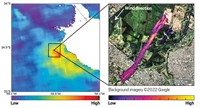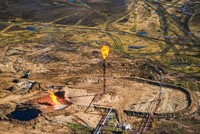Advertisement
Grab your lab coat. Let's get started
Welcome!
Welcome!
Create an account below to get 6 C&EN articles per month, receive newsletters and more - all free.
It seems this is your first time logging in online. Please enter the following information to continue.
As an ACS member you automatically get access to this site. All we need is few more details to create your reading experience.
Not you? Sign in with a different account.
Not you? Sign in with a different account.
ERROR 1
ERROR 1
ERROR 2
ERROR 2
ERROR 2
ERROR 2
ERROR 2
Password and Confirm password must match.
If you have an ACS member number, please enter it here so we can link this account to your membership. (optional)
ERROR 2
ACS values your privacy. By submitting your information, you are gaining access to C&EN and subscribing to our weekly newsletter. We use the information you provide to make your reading experience better, and we will never sell your data to third party members.
Greenhouse Gases
Satellites spy huge methane emissions from oil and gas sites
2 surveys—one global, the other focused on Turkmenistan—reveal shocking extent of avoidable greenhouse gas emissions
by Mark Peplow, special to C&EN
February 14, 2022

Oil and gas production sites collectively vent enormous amounts of methane into the atmosphere, but scientists have often struggled to single out the worst culprits. Two new satellite-based surveys have now identified some of the industry’s biggest methane sources and found they spew even more gas than was previously thought. Because methane is a powerful greenhouse gas, preventing these emissions could offer a way to rapidly reduce the industry’s climate impact.
The first survey found that methane emissions from dozens of crude oil production sites in Turkmenistan increased sharply in 2020 (Environ. Sci. Technol. 2022, DOI: 10.1021/acs.est.1c04873), while the second revealed that similar gas releases are common at many other oil and gas industry sites around the world (Science 2022, DOI: 10.1126/science.abj4351).
“We had thought they were accidental and rare. And we discovered that they’re not as rare as we thought, and they were not accidental,” says Thomas Lauvaux at the Laboratory for Climate and Environment Sciences at the University of Paris-Saclay, who led the second study. He adds that there is a pressing need for tougher regulation on companies’ emissions and better enforcement. “Everything is already possible, it’s just a matter of political will,” he says.
Turkmenistan was already known to be one of the world’s top methane emitters, but it wasn’t clear exactly where the gas was coming from. “This is happening in a country where external access to the data is very difficult,” says Itziar Irakulis-Loitxate, a graduate student at the Polytechnic University of Valencia, who led the Turkmenistan survey. “Without satellites, it would be very difficult to verify the origins of the emissions.”
Irakulis-Loitxate’s team combined data from spectrometers and cameras on several different satellites to paint a detailed picture of Turkmenistan’s emissions. Some instruments—such as the TROPOMI (TROPospheric Ozone Monitoring Instrument) sensor—provided a broad-brush daily overview of the area, while others—the satellites Prisma, ZY 1 02D, Landsat, and Sentinel-2—offered less frequent but more spatially precise methane measurements. This combination allowed the researchers to pinpoint methane plumes at a resolution of 20–30 m and watch how they changed over time.
The team identified 29 methane plumes that sporadically pumped up to 20 metric tons (t) of methane per hour into the air from January 2017 to November 2020. Twenty-four of the sites were production facilities managed by the state-owned companies Turkmenoil and Turkmengaz. Most of the remaining sources were leaky pipelines. As of C&EN’s deadline, neither company responded to interview requests.
Overall, methane emissions in the Turkmenistan survey area roughly doubled between 2018 and 2020, partly because many of these sites had switched from burning excess methane—a practice called flaring—to untrammeled venting instead. Methane has more than 80 times the global warming potential of CO2 during the first 20 years after it is released, so converting methane to CO2 by burning reduces the climate impact, although it pollutes the air in other ways.
In the second study, a team led by Lauvaux used similar satellite data to map major methane emissions around the globe during 2019 and 2020. Although they could only narrow down sources to within a few kilometers using TROPOMI data, roughly two-thirds of the plumes were clearly associated with the oil and gas industry, with the remainder from coal mining, agriculture, or waste management.
The oil and gas industry plumes collectively released about 8 million t of methane per year, making up roughly 10% of the industry’s estimated global emissions. Turkmenistan was responsible for more emissions than any other country, followed by Russia, the US, Iran, Kazakhstan, and Algeria.
Lauvaux says he was shocked by the extent of the methane releases. “We were surprised to see that even the US doesn’t do a great job,” he says. Most of the releases were probably not caused by sudden accidents, he adds. Equipment failures that release methane can take weeks or months to fix, but many plumes they saw appeared for only a day or so at a time, implying deliberate venting.
“In general, their conclusions are consistent with what we have found,” Irakulis-Loitxate says. Lauvaux adds that the two studies are also complementary: while his work provides a global overview, the Turkmenistan study gives “a much more precise view of the plumes.” Both approaches could give policymakers a powerful way to monitor methane emissions, he says.
In November 2021, more than 100 countries signed the Global Methane Pledge to decrease methane emissions by at least 30% between 2020 and 2030. Satellite surveys will be an essential way to assess whether countries actually stick to that pledge. “Politicians should use whatever tools they can to try to curb these emissions as soon as possible,” says Irakulis-Loitxate.
Update
This story was updated on Feb. 18, 2022, to use the preferred translated name of the institution where the global survey was conducted. It is the Laboratory for Climate and Environment Sciences, not the Climate and Environment Sciences Laboratory.
This story was updated on Feb. 15, 2022, to add a caption to the image.





Join the conversation
Contact the reporter
Submit a Letter to the Editor for publication
Engage with us on Twitter